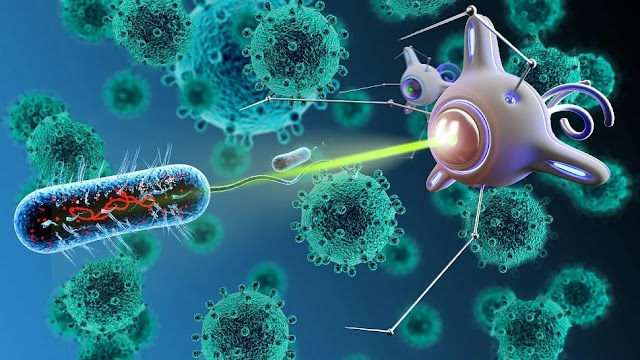Nanotechnology is the engineering and science of materials, devices, and systems that govern structure and composition at the nanoscale (1 to 100 nanometers). Nanoscale materials and systems unique physical and chemical features open up new possibilities for a wide range of applications, including electronics, energy, medicine, and materials research.
The topic of nanotechnology is expanding quickly and is changing how we live and work. By allowing the development of novel materials and technologies with increased performance and usefulness, the growth of nanotechnology has the potential to revolutionize numerous sectors.
Features of Nano Technology :
Utilizing the distinct physical and chemical features of nanoscale materials is one of the major advantages of nanotechnology. Nanotechnology is a significant enabling technology for many industries and applications because these characteristics are distinct from those of bulk materials and are sometimes far more desired.
Nano Technology in Electronics :
Electronics is one of the most promising applications of nanotechnology. Faster, smaller, and more effective electronics may be made using nanoscale materials and devices. The use of nanoscale components and technologies in electronic systems is referred to as nanotechnology.
- Increased surface area, higher mechanical strength, and better electrical conductivity are just a few of the special physical and chemical characteristics of nanoscale materials.
- Various Applications in everything from computer and telephony to wearable technology and the Internet of Things (IoT).
- Nanoscale transistors for high-performance computing, nanowire-based sensors for wearable technology, and nanocomposites for energy storage are a few examples of how nanotechnology is being used in electronics.
Nanotechnology as the developments of new methods :
New procedures and techniques have been developed as a result of nanotechnology in a number of industries, including medical, energy, materials science, and electronics. Nanotechnology has made it possible to create biosensors, imaging probes, and tailored medication delivery systems in medicine.
- Nanotechnology has cleared the way for better solar cells, more effective fuel cells, and cutting-edge battery technologies in the energy sector.
- Nanotechnology has aided in the development of novel catalysts for chemical processes as well as stronger and lighter materials in the field of materials science.
- Nanotechnology has made it possible to create high-performance computer devices, flexible and wearable electronics, and more effective energy storage systems in the field of electronics.
- The creation of brand-new instruments and processes for the manufacturing and manipulation of nanoscale components is another aspect of the field of nanotechnology.
Nanotechnology in the field of Medicine :
With novel options for illness detection, treatment, and prevention, nanotechnology has had a tremendous influence on medicine. Examples of applications of nanotechnology in medicine include :
Nanoparticles :
Systems for delivering therapeutics using nanoparticles: By carrying medications right to damaged cells, nanoparticles can improve the efficacy of therapies while reducing their negative effects.
Nanodiagnostics:
Early illness detection using nanoscale imaging probes and biosensors enables quicker and more efficient therapy.
Tissue Engineering:
By using nanoscale materials and methods, artificial tissues and organs may be created for transplantation, providing fresh approaches to the problem of the lack of suitable organs.
Cancer Therapy :
New cancer treatments have been created using nanotechnology, such as photodynamic therapy, which targets and kills cancer cells using light-sensitive nanoparticles, and thermal therapy, which employs tiny heat sources to eradicate tumors.
Implanted medical devices:
Nanotechnology has made it possible to create implantable medical devices that can continually monitor and regulate the levels of particular chemicals in the body, such as glucose monitors for persons with diabetes.
Nanotechnology in Energy Sectors :
The energy industry has benefited greatly from nanotechnology, which has provided fresh approaches to energy production, storage, and conservation. Examples of how nanotechnology is being used in the energy sector include:
Solar cells :
Nanotechnology has been applied to boost solar cells' performance and efficiency, resulting in more affordable and effective renewable energy sources.
Energy storage :
Advanced batteries and super capacitors have been created using nano scale materials and processes, which provide better energy storage capacities for renewable energy sources.
Energy conservation :
Nanotechnology has been employed to create insulating materials and more energy-efficient lighting, including LED lights, which has resulted in considerable energy savings.
Fuel cells :
A clean and sustainable source of energy, fuel cells have been improved upon with the use of nanotechnology.
Oil and gas :
Nanotechnology has been utilized to reduce the environmental effect of these sectors while also increasing the efficiency of oil and gas extraction.
Nanotechnology in environmental protection :
Nanotechnology has the potential to significantly contribute to environmental conservation by providing fresh approaches to waste reduction and environmental cleanup.
How nanotechnology is being used to safeguard environment :
Water filtering devices :
Water filtration devices that are highly effective at removing impurities from water have been developed using nanotechnology.
Air purification :
Air filtration devices that may remove contaminants from the air, such as volatile organic compounds (VOCs), have been developed using nanotechnology.
Trash management :
New techniques for recycling waste and turning it into usable items have been developed using nanotechnology, minimizing the quantity of waste that ends up in landfills.
Remediation of contaminated sites :
The removal of heavy metals and other pollutants from soil and groundwater is one example of how innovative techniques for remediating damaged areas have been developed using nanotechnology.
Energy from renewable sources :
Nanotechnology has been utilized to increase the effectiveness of renewable energy sources, such as solar cells and wind turbines, lowering their environmental impact and increasing their economic viability.
Conclusions :
As a fast evolving discipline, nanotechnology has the potential to alter a variety of sectors and provide solutions for some of the most important societal issues. Nanotechnology is already having a significant impact, and its potential is only now starting to be realized.
From enhancing the effectiveness of renewable energy sources and enabling the development of new medical treatments to improving environmental protection and reducing waste, nanotechnology is already having a significant impact.







0 Comments